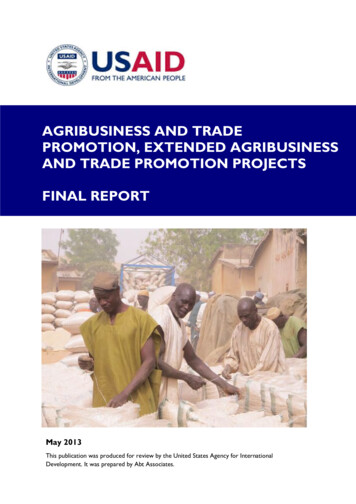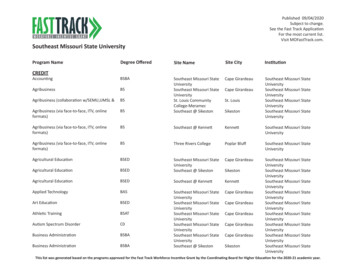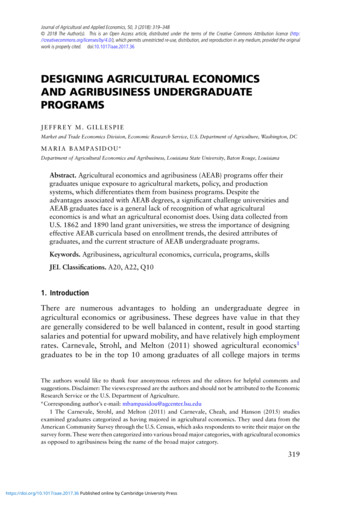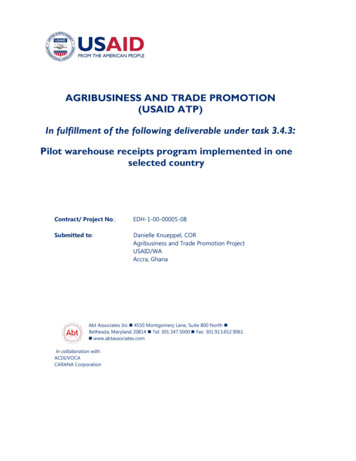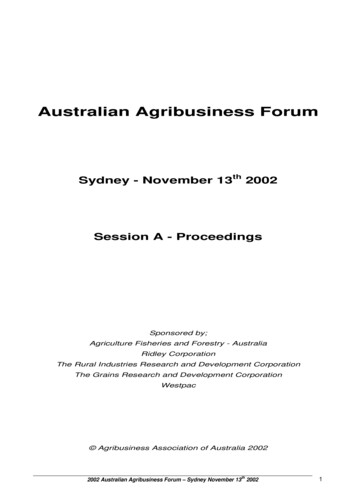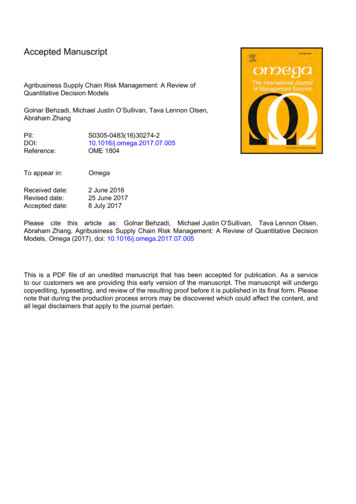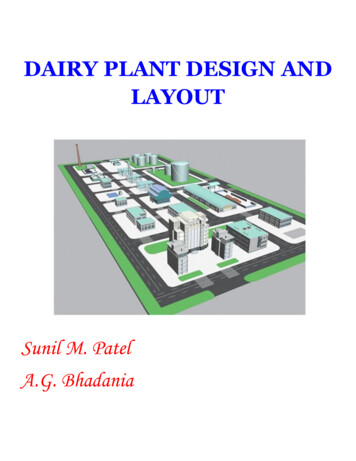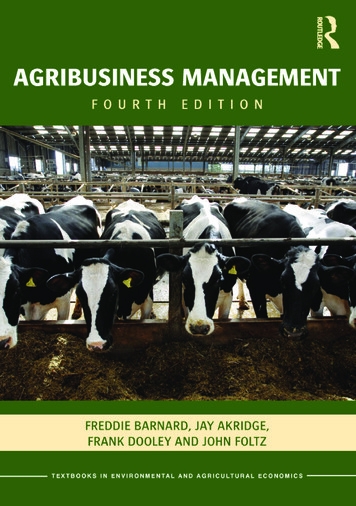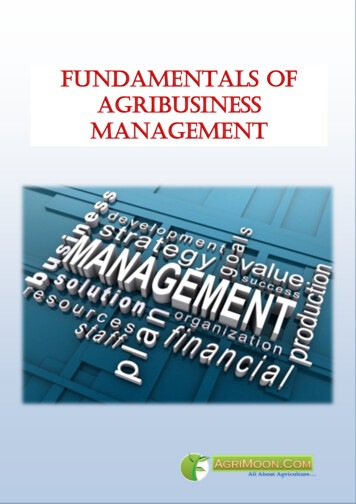
Transcription
Fundamentals ofAgribusinessManagement
AECO 341 - Fundamentals of Agri business management (1 1)AuthorTNAU, Tamil Nadu
IndexLecture1. Agribusiness2. Small business3. Management4. Planning5. Organizing6. Directing7. Controlling8. Production management9. Materials management10. Marketing management11. Personnel management12. Financial management13. Management information system14. Government programmers and regulationsfor agribusiness15. Agricultural inputs and agro-processingPage -110111-119120-133134-136137-147148-157
Fundamentals of AgriBusiness ManagementLecture 1AGRIBUSINESSJohn H. Davis of Harvard University first used the term agribusiness in 1955. In 1980s it was given threeconnotations: (1) synonymous with term agriculture, (2) synonymous with agricultural economics and (3) amodified concept of agriculture, excluding farming, or the off-farm aspects of agriculture.At present, agribusiness is defined as all business enterprises or sells to farmers / traders / consumers. Thetransaction may involve either an input or a produce or service and encompasses items such as:1) Productive resources (feed, seed, fertilizer, equipment, energy, pesticides, machinery, etc.)2) Agricultural commodities –(raw and processed commodities of food and fiber)3) Facilitative services (credit, insurance, marketing, storage, processing, transportation, packing,distribution, consultancy, soil testing etc.).Scope for Agribusiness in India1. India is endowed with varied ago-climate, which facilitates production of temperate, sub-tropical andtropical agricultural commodities.2. There is growing demand for agricultural inputs like feed and fodder, inorganic fertilizers, bio-fertilizers.3. Biotechnology applications in agriculture have vast scope in production of seed, bio-control agents,industrial harnessing of microbes for bakery products.4. Export can be harnessed as a source of economic growth. As a signatory of World Trade Organization,India has vast potential to improve it present position in the World trade of agricultural commoditiesboth raw and processed form. The products line include cereals, pulses, oilseeds and oils, oil meal,spices and condiments, fruits and vegetables, flowers, medicinal plants and essential oils, agricultural4www.AgriMoon.Com
Fundamentals of AgriBusiness Management5.6.7.8.9.10.11.12.13.14.15.advisory services, agricultural tools and implements, meat, milk and milk products, fish and fishproducts, ornamental fish, forest by products etc.At present processing is done at primary level only and the rising standard of living expandsopportunities for secondary and tertiary processing of agricultural commodities.The vast coastal line and internal water courses provides enormous opportunity for production of marineand inland fish and ornamental fish culture gaining popularity with increase in aesthetic value amongthe citizens of India.The livestock wealth gives enormous scope for production of meat, milk and milk products, poultryproducts etcThe forest resources can be utilized for production of by products of forestry.Beekeeping and apiary can be taken up on large scale in India.Mushroom production for domestic consumption and export can be enhanced with improvement in thestate of art of their production.Organic farming has highest potential in India as the pesticide and inorganic fertilizer application are lessin India compared to industrial nations of the world. The farmers can be encouraged and educated toswitch over for organic farming.There is wide scope for production and promotion of bio-pesticides and bio-control agents for protectionof crops.Seeds, hybrid and genetically modified crops, have the highest potential in India in the future, since theproductivity of high yielding varieties have reached a plateau.Micro-irrigation systems and labor saving farm equipments have good potential for the years to comedue to declining groundwater level and labor scarcity for agricultural operations like weeding,transplanting and harvesting.Production of vegetables and flowers under green house conditions can be taken up to harness the exportmarket.5www.AgriMoon.Com
Fundamentals of AgriBusiness Management16. Trained human resources in agriculture and allied sciences will take on agricultural extension systemdue to dwindling resources of state finance and down sizing the present government agriculturalextension staff as consulting sevices.17. The enhanced agricultural production throws open opportunities for employment in marketing,transport, cold storage and warehousing facilities, credit, insurance and logistic support services.Types of Small BusinessesWith the exception of Government, most of the small businesses can be classified as the following types1) Production2) Retailing3) Distribution4) Personal services5) Professional services6) Financial7) Franchising1. Production: This classification includes all types of production including agricultural production of cropsand livestock , as well as forestry.2. Distribution: This classification refers to those businesses, which do not make anything but which bringthe goods and services to the consumer or user. This includes such activities as packaging, labeling,transporting, refrigerating, freezing, processing, storing, and performing any service necessary to prepare thegoods or to provide the service to eventual consumer.3. Retailing: Although often included as a phase of distribution, retailing is listed as a separate categorybecause there are a large number of persons employed in retailing. Obviously it represents one of the best6www.AgriMoon.Com
Fundamentals of AgriBusiness Managementopportunities for the potential entrepreneur. Retailing is that stage of distribution, which deals with theconsumers. Examples of retailers are grocers, self-service sores, florists, agricultural input retailing.4. Personal services: The service business is those, which do not primarily supply goods to the public, butinstead perform a service. Goods may be used to perform the service but they are of secondary importance.Examples of personal service are hotels, restaurants, agro-service centers.5. Professional services: Some type of services, in order to protect the public, requires considerable trainingon the part of those offering the service. Usually those professional services must have a formal educationand rigid examinations before receiving licenses to offer their services to the public. Examples of thoseoffering services are investment brokers, insurance agents etc.6. Financial: Financial businesses are usually service-oriented but since they deal primarily with the loaningor investing of money or the equivalents of money (stocks, bonds, property rights, etc) a separate categorydescribes them best. Examples of financial services are commercial banks, insurance companies, thrift andloan societies etc.7.Franchising: Franchising is a system for selectively distributing goods or services through outlets owned bythe franchisee. Basically, a franchise is a patent or trademark, license, entitling the holder to market particularproducts or services under a brand name or trademark according to prearranged terms and conditions. Thefranchiser is the owner of his or her own business( the franchisee) is likely to be more diligent and striveharder for success than the hired manager of a company-owned outlet. Since franchising is form of selectivedistribution, the typical franchise agreement prohibits the franchise from setting up competing outlets withinthe franchise area. Examples of franchise services are diet services, quick-service food-drive inns like friedchicken.Forms of the Business OrganizationsThere are three basic forms of business organization methods: the sole proprietorship, the partnership, andthe corporation. With only a few limited exceptions, any type of business venture can use nay form ofbusiness organization. The factors that will affect the business form chosen are:7www.AgriMoon.Com
Fundamentals of AgriBusiness Management1.2.3.4.5.Ease of formationExposure to financial riskAbility to raise capitalTax treatment of incomeContinuity of business upon the death of owner.8www.AgriMoon.Com
Fundamentals of AgriBusiness ManagementA comparison of the three forms of Business organizationFACTORSPARTNERSHIPCORPORATIONNumber of ownersEase of formationDegree of financialriskSOLEPROPREITORSHIPOneVery easyOwner is responsiblefor all debtsTwo or moreEasy to very easyPartners share responsibility fordebtsAbility to borrowfundsLimited ability ofowner to borrowImproved ability to borrow due tomultiple ownersLegal requirementsNone, except forpossible declarationof nameAs part of owner‟spersonal tax returnSame as sole proprietorship; writtencontract between partnersrecommendedProfits are divided up amongowners and are taxed on eachpartner‟s tax returnBusiness may be terminated at deathof any partner, unless provisions forcontinuation are madeOne or moreModerate to easyOwners have only limitedresponsibility for debts inname of companyCan borrow funds directlyfrom public through sharesand debenturesCharter must be secured fromstateHow taxes arehandledContinuity ofbusinessBusiness isterminated at deathof ownerPays own income taxBusiness continues after deathof any stockholderEntrepreneurMany economic theories emphasize the significant role played by individual entrepreneurs as they combinetalents, abilities and drive to transform resources into profitable undertakings. Joseph Schumpeter, was the9www.AgriMoon.Com
Fundamentals of AgriBusiness Managementfirst major writer to highlight the human agent in the process of economic development. He believed thatthe economy was propelled by the activities of persons who wanted to promote new goods and new methodsof productions or to exploit a new source of materials or new market not merely for profit but also for thepurpose of creating.Likewise, Arthur W. Lewis contended that economic growth was bound to be slow unless there was anadequate supply of entrepreneurs looking out for new ideas, and willing to take the risk of introducing them.The relation between self –sustained growth of an economy and entrepreneurship was further discussed byW.W. Rostow when he claimed that,, “ economic growth was the result of an interesting process involvingthe economic, social and political sectors of society, including emergence of corps of entrepreneurs who arepsychologically motivated and technologically prepared regularly to lead the way in introducing newproduction functions in the economy‟‟ .As it is, experts as have variously described the entrepreneur A person who innovates One who allocates and manages the factors of production and bears risk One who has ability to perceive latent economic opportunities and devise their exploitation An individual who conceives the ideas of business, design the organization of firms, accumulatescapital, recruits labour, establishes relations with supplier, customers and the government andconverts the conception into a functional organization. The supplier of resources, supervisor and coordinator and ultimate decision maker.The Importance of Personality in BusinessOne of the most important assets of any business owner is a personality, which lends itself to the type ofbusiness chosen. There are many different kinds of business and innumerable types of personalities. Anobjective self-examination is therefore necessary for the discovery of personal strengths and weaknesses,especially as they relate to owning a particular type of business. In assessing one‟s own personality, the10www.AgriMoon.Com
Fundamentals of AgriBusiness Managementfollowing inventory should prove helpful. Potential business owners should question themselves on each ofthese items, noting those areas where improvement is most needed.A. Physical Qualities1. Appearance2. General health3. Endurance4. Vision5. HearingB. Mental Abilities1. General intelligence2. Knowledge of business3. Speed of reaction4. Memory5. Creativeness6. Initiative7. Insight into characterC. Ethics1. Honesty2. Loyalty3. Dependability4. PerseveranceD .Social Qualities1. Courtesy2. Sympathy3. Ability to work with others4. Cheerfulness5. Self-confidence11www.AgriMoon.Com
Fundamentals of AgriBusiness Management6. Adaptability7. EnthusiasmE. Executive Qualities1. Ability to direct others2. Ability to organize3. Ability to make decisions4. Ability to take responsibility5. Ability to accept suggestionsEntrepreneurial CompetenciesA competency is an underlying characteristic of a person, which results in effective and / orsuperior performance in a job. Competence is an underlying characteristic of a person, in that it may bemotive/traits/skills or aspect of one‟s self-image or a body of knowledge which one uses. The existence ofthese characteristics may or may not be known to the person. In this sense, the characteristic may beunconscious aspect of the person. In simple terms a competence is a combination of a body of knowledge,skills and cluster of appropriate motives / traits and motives that an individual possesses to perform a giventask effectively and efficiently. The fifteen identified entrepreneurial competencies are furnished below.1. InitiativeTakes action that go beyond job requirements or the demand of the situation. Does things before being asked or forced to by events Acts to extend the business to new areas, products or services.2. Seeing and acting on opportunities12www.AgriMoon.Com
Fundamentals of AgriBusiness ManagementLooks for and takes action on opportunities Sees and acts on opportunities ( Business, educational or personal growth) Seizes unusual opportunities to obtain financing equipment, land work, space, or assistance.3. Persistence Takes repeated or different actions to overcome obstacle Takes action in the face of a significant obstacle4. Information seekingTakes action on own to get information to help reach objectives or clarify problems. Does personal research on how to provide a product or service Seeks information or asks questions to clarify what is wanted or needed Personally undertakes research, analysis or investigationUses contacts or information networks to obtain useful information5. Concern for high quality of workActs to do things that meet or beat existing standards of excellence States a desire to produce work of high quality Compares own work or own company‟s work favourably to that of others.6. Commitment to work contractPlaces the highest priority or getting a job completed Makes a personal sacrifice or expands extraordinary effort to complete a job Accepts full responsibility for problems in completing a job for others Pitches in with workers or works in their place to get the job done13www.AgriMoon.Com
Fundamentals of AgriBusiness Management Expresses a concern for satisfying the customer7. Efficiency orientationFinds ways to do things faster or with few resources or at a lower cost. Looks for or finds ways to do things faster or at less cost Uses information or business tools to improve efficiency8. Systematic planningDevelops and uses the logical, step-by-step plans to reach goals Plans by breaking a large task down into sub-tasks Develops plans that anticipate obstacles Evaluates alternatives Takes a logical and systematic approach to activities9. Problem solvingIdentifies new and potentially unique ideas to reach goals Identify an alternative strategy to reach a goal Generate new ideas or innovative to reach a goal10. Self-confidenceHas a strong belief in self and own abilities Express confidence in own ability to complete a task or meet a challenge Sticks with own judgment in the face of opposition or early lack of success Does something that he says is risky14www.AgriMoon.Com
Fundamentals of AgriBusiness Management11. AssertivenessConfronts problems and issues with others directly Tells others what they have to do Reprimands or disciplines those failing to perform as expected12. PersuasionSuccessfully persuades others Convinces someone to buy a product or service Convinces someone to provide financing Convinces someone to do something else that would like that person to do Asserts own competence, reliability or other personal or company‟s qualities Asserts strong confidence in own company‟s or organization‟s products or services13. Use of influence strategies Acts to develop business contacts Uses influential people as agents to accomplish own objectives Selectively limits the information given to others Uses a strategy or influence or persuade others14. Monitoring Develops or uses procedures to ensure that work is completed or that work gets standards or quality Personally supervises all aspects of a project15. Concern for relevant others welfare Takes action to improve the welfare of employees Takes positive action in response to employees personal concerns Expresses concern about the welfare of employees.15www.AgriMoon.Com
Fundamentals of AgriBusiness ManagementLecture 2SMALL BUSINESSSmall Scale Industry in the Indian Economy Development16www.AgriMoon.Com
Fundamentals of AgriBusiness ManagementSmall businesses / small-scale industrial units are playing an important role in the economicdevelopment of any nation. Although it is not generally recognized, this segment of our economy includessome of the dynamic, profitable and interesting firms. In India, there are 32.25 lakhs small-scale industrialunits / businesses in the SSI sector, employing 177.30 lakh persons (1999-2000). The output of this sector isaround Rs.5, 78,470 crores. The export amounted to Rs.53, 975 crores. SSIs contribute up to 40 per cent ofgross turnover in manufacturing sector, 45% of the manufacturing exports and 35% of the total exports. SSIsector, contributes 7% of the GDP. During this era of economic liberalization, the growth of the SSI sector israther quite perceptible.Definition of Small Scale IndustryThere is no generally accepted definition of a „small business‟. The definitions vary all the way fromcountry to country and Government-to-Government in a country. The following are some of the definitions.In the USA, in the Small Business Act 1953, congress defined a small business as one that isindependently owned and operated and which is not dominant in its field of operation.In India, the Department of Small Scale and Agro and Rural Industries considered small businessesas a sector and given the following definitions.17www.AgriMoon.Com
Fundamentals of AgriBusiness Management1. Small Scale Industrial UndertakingAn industrial undertaking in which the investment in fixed assets in Plant and Machinery, whetherheld in ownership terms or on lease or by hire purchase, does not exceed Rs.100 lakhs is called a Small ScaleIndustrial Undertaking.2. Ancillary Industrial UndertakingAn industrial undertaking which is engaged or proposed to be engaged in the manufacture orproduction of parts, components, sub-assemblies, tooling or intermediates or the rendering of services andthe undertaking supplies or renders or proposes to supply or render not less than 50% of its production orservices as the case may be to one or more other industrial undertakings and whose investment in fixed assetsin Plant and Machinery, whether held on ownership terms or on lease or on by hire purchase does not exceedRs.100 lakhs is called an Ancillary Industrial Undertaking.3. Tiny EnterprisesAll small-scale units with investment limit in Plant and Machinery up to Rs.25 lakhs irrespective ofthe location of the unit are called tiny enterprises.4. Export Oriented UnitsUnits having fixed assets in Plant and Machinery not exceeding Rs.100 lakhs and which undertake toexport at least 30% of its current production by the end of 3rd year from the date of its commencing ofproduction are called Export Oriented Units (EOU).5. Small Scale (Industrial related) Service and Business Enterprises (SSSBE)Industry related Service and Business Enterprises with investment up to Rs.5 lakhs in fixed assetsexcluding Land and Building are called Small scale (Industry related) Service and Business Enterprises(SSSBE).6. Women EnterprisesWomen enterprises are those small-scale units, where one or more women entrepreneurs have notless than 51% of financial holding. Such units are given more concessions and encouragement.7. Village and Small Scale Industries (24.12.1999)18www.AgriMoon.Com
Fundamentals of AgriBusiness ManagementPower looms---------------------- Modern segmentKhadi and Village industriesHandloomsSericultureTraditional segmentHandicraftsCoir unitsObjectives of A Small BusinessObjectives are the ends towards which all the activities of the organization are directed.1. Service2. Profit3. Community participation4. Growth5. SubsidiariesCharacteristicsThe above definitions exhibit the following characteristics associated with small business and smallscale units.1. Characterized by smallness2. Involves lesser capital3. Mostly one man venture4. They are highly diversified – wide range of products5. Wide dispersal geographicallyImportanceThere are a number of reasons why smaller firms are of importance to our economy.1.They are the important sources of competition and challenge the economic power of larger firms2.They broaden the distribution of economic and political power and does not result in concentration ofpower19www.AgriMoon.Com
Fundamentals of AgriBusiness Management3.4.They are the sources of innovation and creativityThey offer career opportunities to those, who are happiest and most productive in the unstructuredenvironment of a small company5.Provide the dynamism, innovation and effectiveness that lead to the productive economic system6.There exists vast agribusiness opportunities in developing economy of India7.Generating employment with minimum investment8.Promoting export9.Control over production widely distributed10. Develop risk takersAdvantages1.Less capital outlay but more employment generation2.Does not require sophisticated technology3.Facilitates decentralization and dispersal of business units4.They offer a wide range of choices to consumers5.Can serve specialized needs6.Utilizes the resources in full without wastageDisadvantages1.Inadequate management ability2.Inadequate finance3.Poor competitive position4.Uncertain business continuity20www.AgriMoon.Com
Fundamentals of AgriBusiness ManagementGrowth StagesFollowing are the various growth stages of any small business units.1. First stage:One person operation - Where owner does allThe activitiesDirector-FounderoperatedOwner - Manager Worker2. Second stage: Separation of management and non-management functions hired subordinates to do someof the manual and / ormental activities while owner managesEarly GrowthOwner- ManagerWorkers3. Third stage Separation of ownership and management functions; owner begins to relinquish theresponsibilities for the day-to-day running of the business activities to a professional manager.One LayerMiddleManagement4. Multi-layer managementOwnerManager (s)21Worker (s)www.AgriMoon.Com
Fundamentals of AgriBusiness ManagementChairmanManaging anceOrganization and AdministrationOrganizational structure and administration for promotion of SSI in India are out lined below:At national Level, under Ministry of Industry an exclusive Department of Small Scale & Agro andRural industries exists since 1991 for the promotion and development of small-scale industries. The Office ofDevelopment Commissioner (Small Scale Industries) has been functioning within the Ministry of Industrysince 1954 as an apex / nodal organ and provides link between the Ministry / Department and fieldorganizations. Since 1991 it has been working as an attached office to the Department of Small Scale & Agroand Rural Industries.22www.AgriMoon.Com
Fundamentals of AgriBusiness ManagementDevelopment Commissioner (Small Scale Industries)The Small Industries Development Organization (SIDO) headed by the Additional Secretary &Development Commissioner (SSI), being an apex body for formulating policies for the development of smallscale industries in the country is playing a very constructive role for strengthening this vital sector. Itfunctions through a network of SISIs, Branch SISIs, Regional Testing Centres, Footwear Training Centres,Production Centre, Field Testing Stations and specialized institutes. It renders services such as:-Advising the Government in policy formulation for the promotion and development of small-scaleindustries.Providing techno-economic and managerial consultancy, common facilities and extension services tosmall scale unitsProviding facilities for technology up gradation, modernization, quality improvement andinfrastructure.Human Resource Development through training and skill up gradation.Providing economic information services.Maintaining a close liaison with the Central Ministries, Planning Commission, State Governments,Financial Institutions and other organizations concerned with development of Small Scale Industries.Evolving and Coordinating Policies and Programmes for development of Small Scale Industries asancillaries to large and medium scale industries.Monitoring of PMRY Scheme.Over the years SIDO has served a very useful purpose as a catalyst of growth of small enterprisesthrough its vast network of field organizations spread over different parts of the country.SSI Board23www.AgriMoon.Com
Fundamentals of AgriBusiness ManagementThe range of development work in Small Scale Industries involves several Department / Ministriesand several organizations of Central / State Governments. To facilitate coordination and inter-institutionallinkage, the Small Industries Board has been constituted. It is an apex advisory body constituted to renderadvice to the Government on all issues pertaining to the small-scale sector. The Industry Minister of theGovernment of India is the Chairman and the Board comprises among others State Industry Ministers, someMembers of Parliament, and Secretaries of various Departments of Government of India, financialinstitutions, public sector undertakings, industry associations and eminent experts in the field. The Board waslast constituted on 26.9.1998 with 93 members besides the Chairman. The term of the Board is for two years.Small Industries Service Institutes (SISIs)There are 28 SISIs and 30 Branch SISIs set up in State capitals and other industrial cities all over thecountry. The main activities of these institutions are as follows:- Assistance / Consultancy to Prospective Entrepreneurs- Assistance / Consultancy rendered to existing units- Preparation of State Industries Profiles- Preparation / Updating of District Industrial Potential Surveys- Project Profiles- Entrepreneurship Development Programmes- Motivational Campaigns- Production Index- Management Development Programmes- Skill Development Programmes- Energy Conservation- Pollution Control- Quality Control & Up gradation24www.AgriMoon.Com
Fundamentals of AgriBusiness Management-Export PromotionAncillary DevelopmentCommon Facility Workshop / LabPreparation of Directory of Specific IndustryIntensive Technical AssistanceCoordination with DICsLinkage with State Govt. FunctionariesMarket SurveysOther Action Plan Activities assigned by HeadquartersSISIs and its Branches have common facility workshops in various trades. There is at present 42 suchcommon facility workshops attached to SISIs / Branch SISIs.Some Current Problems Worrying Small ion/ policy in generalInflationTaxesGovt. paper worksLabour unionsHigh interest ratesEnvironmental restrictionsLack of required capitalMinimum Wage LawsCorruptive and bureaucratic officialdomSeasonality in agricultural production and interruptions in raw materials availabilitySeasonality in demand for agricultural inputs25www.AgriMoon.Com
Fundamentals of AgriBusiness Management13.Lack of appropriate technologyBusiness Failure May Result From One or More of the Following Weakness1.Lack of business records2.Lack of business experience3.Insufficient stock-turnover4.Uncollected Accounts receivables5.Inventory shrinkage6.Poor inventory control7.Lack of finance8.Improper mark-up9.Lack of sales10. Too much left to chance11. Crucial obstacles go un-noticed through ignorance.26www.AgriMoon.Com
Fundamentals of AgriBusiness ManagementENTREPRENERIAL OPPORTUNITIES IN MODERN AGRICULTUREFARMING(ON FARM)1. Crop2.Dairy/Poutry/ l plants8.Palmrosa9.Fodder10.Sericultue11. Agro-forestry12. retail3.CommissionAgent4. Transport5. INPUTSMARKETING1.Ferilizer2. Agrl. Chemicals3.SeedsPROCESSING4. Machineries5.Animal feed6.Poultry .Custom service11.Bio-control units12.Bio-tech tle10.Tannery11.Brewery12.P. board1.Milk2.Fruits3.vegetablesFACILITATIVE1.R & y are Enterprises, Entrepreneurs and Environment. Already we discussed on the entrepreneurial personality,abilities, motives and competencies. Also we have discussed on the enterprises opportunities and their feasibility andviability, only those enterprises meeting the feasibility and viability will be considered for taking. Next importantthing is the environment in which the enterprises and entrepreneurs function.The environment factors or forces which affect the success of business are into (1) Economic environment, (2)Demographic environment, (3) Socio-cultural environment, (4) Technological environment (5) Political environment,27and (6) Legal environment.www.AgriMoon.Com
Fundamentals of AgriBusiness ManagementImpo
these items, noting those areas where improvement is most needed. A. Physical Qualities 1. Appearance 2. General health 3. Endurance 4. Vision 5. Hearing B. Mental Abilities 1. General intelligence 2. Knowledge of business 3. Speed of reaction 4. Memory 5. Creativeness 6. Initiative 7. Ins
